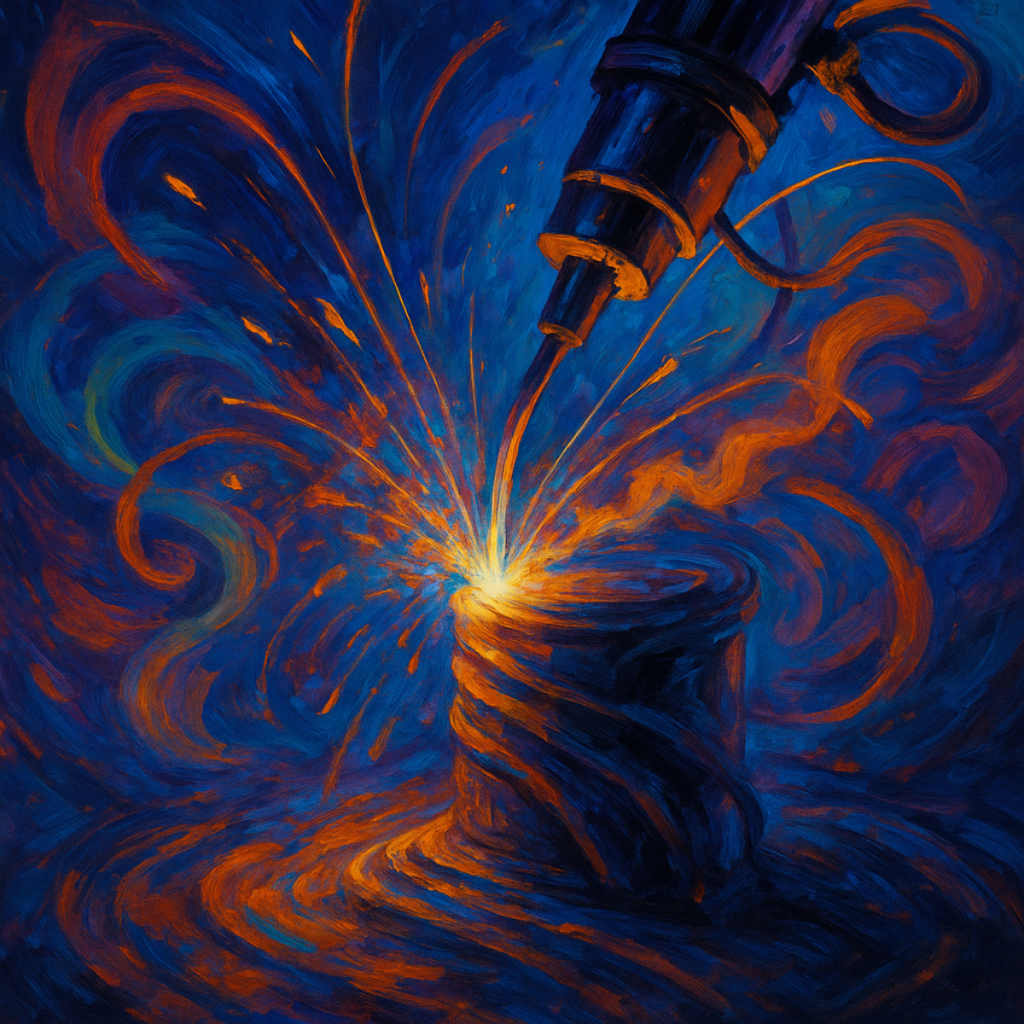Semi-finalist 2025
| Submitted by: | Mia Abdulla |
| Department: | Chemical + Materials Engineering |
| Faculty: | Engineering |
This image captures the poetry of transformation in metal 3D printing—where heat, motion, and material converge to create form. The swirling strokes of orange and blue reflect the intense thermal gradients and fluid dynamics at the heart of the process. Each layer deposited is shaped not only by the wire and arc, but by precise orchestration of energy, time, and metallurgy. My research explores how these thermal histories affect the structure and performance of the final part, particularly in critical components used in energy infrastructure. This work contributes to building trust in additive manufacturing by showing that beauty and function can coexist—even in extreme conditions. The image is both a literal and symbolic expression of how innovation is built: not all at once, but layer by layer, in a balance of force and finesse.
Was your image created using Generative AI?
Yes.
Did you upload any materials into an AI tool to help generate your image?
Yes.
Which model of generative AI did you use?
DALL-E 2 by OpenAI.
How was your image created?
This image was generated using an AI tool (image generation), guided by original experimental work conducted in the field of metal 3D printing. I took photographs of a physical component I built that closely resembles the structure depicted in the image, along with thermal gradient patterns observed during laboratory experiments. These were uploaded to the AI system to shape the final visualization. The AI tool was used to evoke the movement of heat and metal, tracing the molten pathways and delicate layering that shape creation. Every element in the final image is rooted in real-world structures, temperature distributions, and fabrication dynamics studied within our lab, reimagined through a conceptual and visual lens.
How did you craft your prompt to guide the generative AI in creating your image? Please describe the technique or approach you used to convey your vision to the AI.
My goal was to convey the dynamic energy and layered growth that define metal 3D printing, using light and motion as metaphors for heat and material transformation. To guide the AI, I uploaded photographs of a fabricated component from my research and incorporated key terms into the prompt such as “molten metal,” “thermal gradients,” “layered deposition,” and “flowing energy.” I emphasized a glowing, fluid aesthetic to reflect the behavior of heat during additive manufacturing. Instead of simply accepting the first results, I guided the image through several refinements, adjusting the flow of light, the depth of color, and the sense of movement to better evoke the layered story of molten metal coming to life. I steered the AI away from overly rigid or mechanical interpretations, using prompts and settings that favored organic forms and fluid energy. The final image reflects not just the technical process of metal 3D printing, but the imagination and craftsmanship that shape each layer into something greater than the sum of its parts.
Please describe what you uploaded to the AI tool, and confirm that the material is your original work, licensed for use (e.g., Creative Commons), used with proper permission.
I uploaded original photographs I captured of a physical metal component that I built as part of my research in metal 3D printing. These photographs depict structures similar to the form represented in the final image. I also uploaded visual references inspired by thermal gradient patterns observed during laboratory experiments at the Canadian Centre for Welding and Joining. All materials are entirely my own work, created using university-owned equipment within the research project. No third-party images, copyrighted elements, identifiable individuals, or sensitive data were included. The AI tool was used solely to interpret and enhance the visual presentation, while preserving the core scientific ideas rooted in my research findings.
Where is the image located?
This image is born from the limitless arenas where metal breathes into form—where robotics, heat, and human ambition weave new structures from fire and wire. It is not anchored to a single lab, but belongs to every place where imagination and industry meet under the hum of creation.

